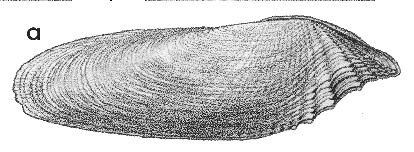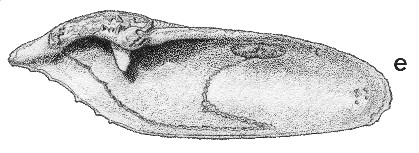
Revised descriptions of New Zealand Cenozoic Mollusca from Beu and Maxwell (1990)

 | Revised descriptions of New Zealand Cenozoic Mollusca from Beu and Maxwell (1990) | 
|
  (Pl. 47a): Castlecliff, Wanganui, Castlecliffian (GNS, from old collection; apparently removed from a bore-hole in a disconformity plane) |
  (Pl. 47e): Castlecliff, Wanganui, Castlecliffian (GNS, from old collection; apparently removed from a bore-hole in a disconformity plane) |
Beu & Maxwell (1990): Chapter 16; p. 346; pl. 47 a,e.
Synonymy: Pholas similis Gray 1835, p. 309; Anchomasa similis
Classification: Pholadidae: Pholadinae
Description: Large for family (68-100 mm long), long and narrow, subcylindrical, tapering slightly to posterior; thick and relatively solid. Anterior end deeply embayed for foot protrusion at all stages; posterior end evenly oval; no groove between anterior and posterior areas. External sculpture of thin, raised, lamellar, commarginal ridges, smooth on posterior but over anterior area raised into many low spinous flutes by low, narrow, widely spaced radial costellae. Antero-dorsal margins raised into sharply recurved edge, smooth and bearing anterior adductor scar in front of umbo, adductor muscle protected in living specimens by large, narrow, relatively thick, medially grooved mesoplax (rarely preserved in fossils). Posterior adductor scar large, elongate-oval, near centre of shell length just below dorsal margin; pallial sinus very deep. Long, thick, curved apophysis beneath each umbo, preserved in some fossils.
Comparison: Barnea similis is moderately common around much of New Zealand today (and particularly around Auckland), boring vertically into Cenozoic mudstone outcrops or, less commonly, into weathered older rocks (e.g., siltstone of Mesozoic flysch beds near Wellington, at Day's Bay and in Pauatahanui Inlet). It is a common fossil in situ, boring in the many disconformity surfaces in the Castlecliff section, and in the marine-planed surfaces at the bases of many Haweran terrace deposits, but is otherwise uncommon (i.e., dislodged shells are not often found in shellbeds). It is very much larger and thicker-shelled than Pholadidea species (and so more often encountered fossil, although usually less common than Pholadidea suteri in the living fauna) and is easily distinguished from them by the lack of an umbonal-ventral groove and by retaining the anterior pedal gape in adults. We follow Turner (in Moore 1969, p. N708) in ranking Anchomasa as a subgenus of Barnea.
Distribution: Opoitian(?)-Recent; Recent, New Zealand (type). Typical specimens are known from Mangapanian-Recent; Opoitian-Waipipian specimens are more narrowly cylindrical, with a shorter anterior end, but intergrade with Nukumaruan-Recent specimens (Beu 2006, p. 295, fig. 38A-E, G, H).
Cite this publication as: "A.G. Beu and J.I. Raine (2009). Revised
descriptions of New Zealand Cenozoic Mollusca from Beu and Maxwell (1990). GNS
Science miscellaneous series no. 27."
© GNS Science, 2009
ISBN
978-0-478-19705-1
ISSN 1177-2441
(Included with a PDF facsimile file
copy of New Zealand Geological Survey Paleontological Bulletin 58 in CD version
from: Publications Officer, GNS Science, P.O. Box 30368 Lower Hutt, New
Zealand)